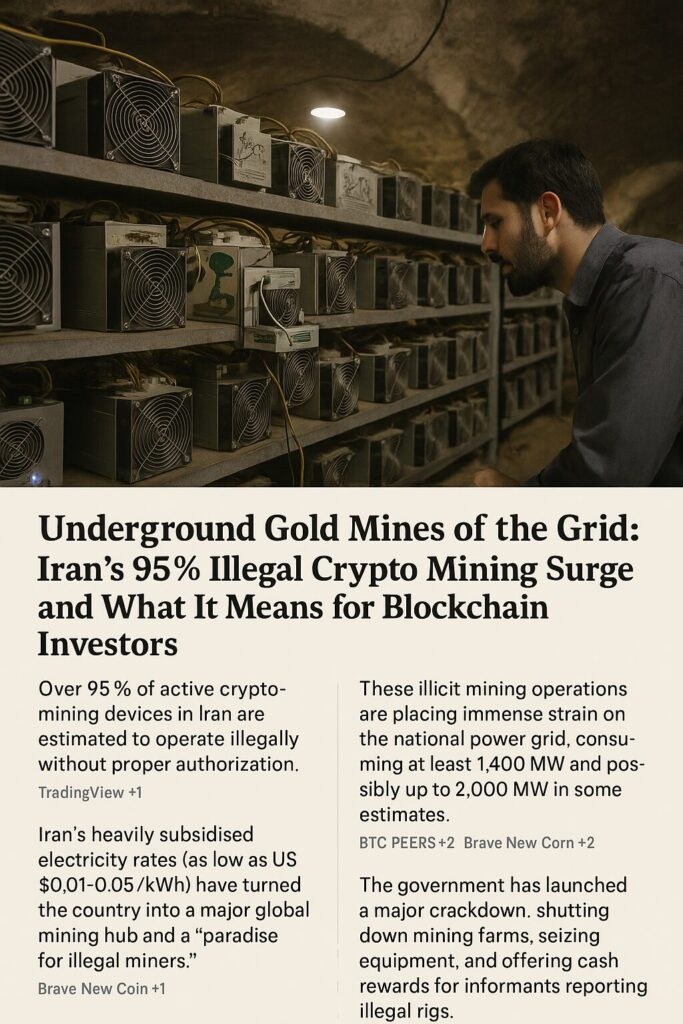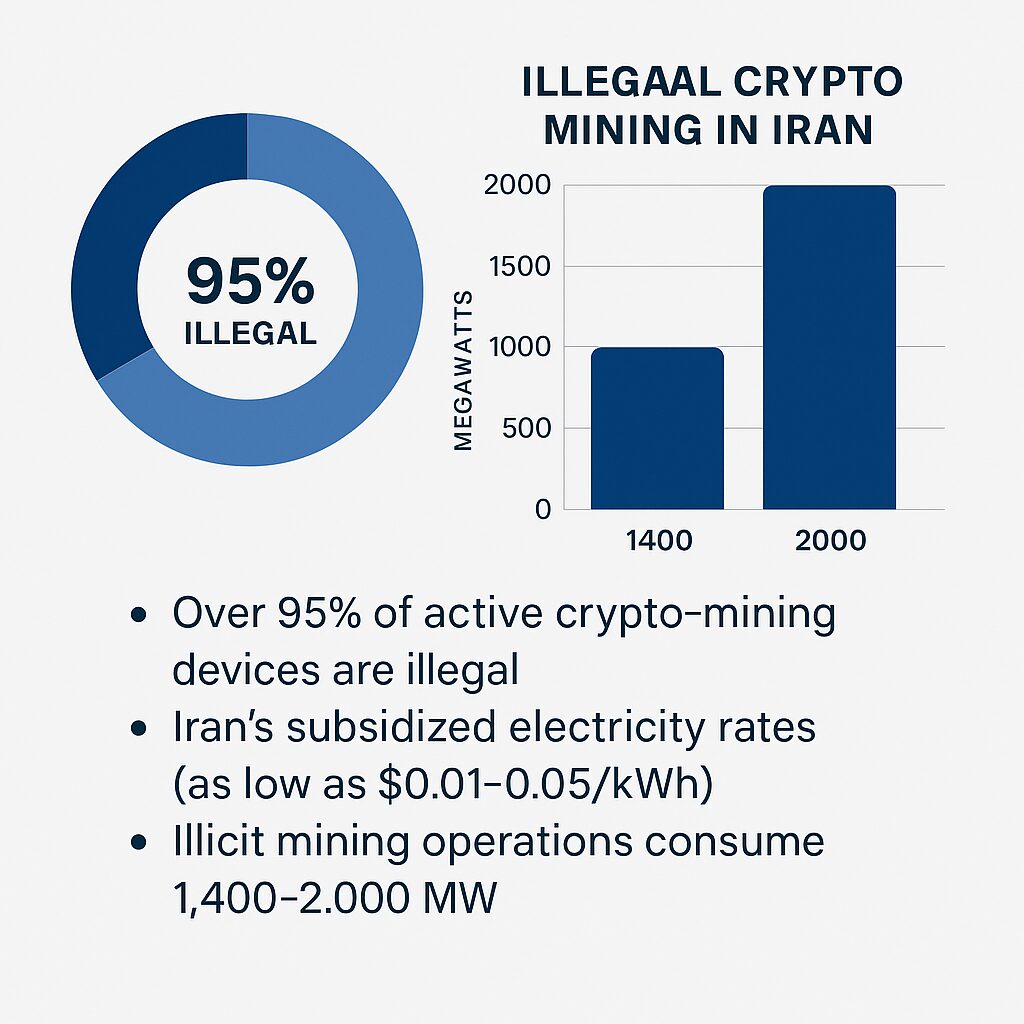
Key Takeaways :
- Over 95 % of active crypto-mining devices in Iran are estimated to operate illegally without proper authorization.
- Iran’s heavily subsidised electricity rates (as low as US $0.01-0.05 /kWh) have turned the country into a major global mining hub and a “paradise for illegal miners.”
- These illicit mining operations are placing immense strain on the national power grid, consuming at least 1,400 MW and possibly up to 2,000 MW in some estimates.
- The government has launched a major crackdown, shutting down mining farms, seizing equipment, and offering cash rewards for informants reporting illegal rigs.
- For blockchain-investors and crypto entrepreneurs, Iran’s case offers a cautionary tale: the profitability of mining in subsidised jurisdictions may be undermined by regulatory and infrastructure risks.
1. Iran’s Rise as a Crypto Mining Hub
In recent years Iran has quietly emerged as one of the world’s largest players in the cryptocurrency-mining ecosystem. As per official estimates, around 427,000 active mining devices are operating in Iran, and shockingly, over 95 % of them are unlicensed and operating outside regulatory oversight.
The reason for this surge is relatively straightforward: electricity in Iran is heavily subsidised by the state—costs of US $0.01 to US $0.05 per kWh are quoted for some users. In the context of mining cryptocurrencies like Bitcoin (BTC) or other proof-of-work (PoW) coins, where electricity cost is a dominant expense, this becomes extremely profitable. One estimate noted that in Iran, the cost to mine one Bitcoin could be as low as around US $1,300 while the global market value is tens of thousands of dollars.
What is particularly striking: one recent article reports that Iran ranks as the world’s fourth-largest country in terms of crypto-mining activity, behind the U.S., Kazakhstan and Russia.
For those searching for new crypto assets or mining opportunities, Iran’s example suggests that regions with ultra-low energy costs can become major mining hubs—however, as we shall see, there are substantial hidden risks.
2. The Illegal Mining Epidemic and Energy Grid Stress

Mining Without a Permit
Despite the legalisation of mining in Iran in 2019, most miners choose to operate off-the-books. The drivers include high tariffs for licensed operations, heavy regulation, required sales of mined coins to the central bank, and surveillance. As a result, miners conceal their operations in abandoned buildings, underground tunnels, factory basements—all to exploit subsidised industrial power rates and blend in with legal users.
Massive Energy Drain on the Grid
Official statements estimate the illicit mining sector consumes at least 1,400 MW, and some estimates go as high as 2,000 MW (2 gigawatts) of electricity. To put that in perspective, 1 GW of power can supply hundreds of thousands of households; so 2 GW is a significant load on the national grid.
Additionally, one source claimed the illegal mining burden accounts for 15-20 % of Iran’s electricity shortage. The nexus of cheap power + hidden mining + infrastructure strain creates serious risk for both the grid and legitimate industry.
Impact: Blackouts and Public Backlash
The strain has not gone unnoticed. The state electricity company in Iran has noted that mining farms are a major driver of blackouts, especially during peak periods. Communities and industries facing power cuts are increasingly frustrated, raising the political cost of inaction.
3. Regulatory Response and Enforcement Measures
Cracking Down on Illegal Farms
In response, Iranian authorities have ramped up inspection and enforcement. For example, in the province of Tehran alone: 104 illegal mining farms were shut down and 1,465 machines were seized recently. The government is targeting hotspots like Pakdasht, Malard, Shahre Qods and industrial zones in southwest Tehran.
Incentivising Public Reporting
In August, the government introduced a bounty‐program: informants who report illegal mining equipment can receive 1 million toman (about US $24) per device. While modest by international standards, this scheme is designed to engage citizens in data-collection and enforcement.
Legalised Mining but Uncompetitive
It is worth noting that legal mining operations do exist in Iran under licence. But many miners find the tariffs and compliance burdens too onerous, which drives them into the underground economy. This regulatory arbitrage is a core reason why illegal mining disproportionately dominates the sector.
4. Implications for Crypto Investors and Blockchain Practitioners
Mining Cost Advantage → But Hidden Risks
On the one hand, low energy costs make Iran (and similar jurisdictions) attractive for mining, which means high profit margins. For those scouting for “next-wave mining locations”, this dynamic is illuminating: look for subsidised or low-cost power, permissive regulatory regimes, and low labor/real-estate cost.
However, the Iran saga underscores major governance risk: heavy state subsidies invite industrial scale mining; the strain on infrastructure provokes regulatory backlash; enforcement can shift overnight; illicit operations undermine grid stability and raise reputational risks. For a mining entrepreneur or token project, the takeaway is: ensure power supply is sustainable, regulated, transparent, and resilient to crackdown.
Infrastructure as a Third-Order Crypto Factor
Most crypto investors look at hashrate, difficulty, coin supply, narrative. But Iran shows how infrastructure (electricity grid, subsidies, regulation) is a third-order but critical factor. A disruption in power can temporarily halt mining, change economics, trigger government shutdowns. For a blockchain engineer or wallet-project developer (such as yourself working on a non-custodial wallet “dzilla Wallet”), this means: if you rely on mining, staking, or network production in a specific geography, you must monitor infrastructure and policy risk.
Regulatory Dynamics Affect Token Issuance and Mining Models
If your upcoming token or presale ecosystem contemplates mining or rewards issuance using PoW mining, the Iran case warns: subsidised energy may make sense initially, but the regulatory backlash, hidden cost of grid impact, and enforcement risk can derail the model. As your project bridges “Asset-Backed Representation” and “Autonomous Trust Tender” models, you should factor in how mining or network-production is regulated and how that intersects with energy and compliance.
Furthermore, for investors seeking new crypto assets and their underlying infrastructure, you might ask: Is the token issuance tied to high-energy PoW mining in stressed grids? If yes, that may increase business risk.
5. Current Trends and What to Watch Going Forward
Shift in Global Mining Jurisdiction Patterns
The Iran story is part of a broader shift: jurisdictions with cheap subsidised power are becoming mining hotspots (or havens), but face increasing regulatory scrutiny. Similar tensions are seen in Kazakhstan, Russia, and parts of the U.S. For example, after China’s mining ban in 2021, global hashrate redistributed globally—but the lesson remains: low‐cost power + weak oversight = growth, but also risk.
Policy & Energy Transition Pressures
Governments worldwide are increasingly sensitive to the environmental and grid‐impact of crypto mining. Iran’s crackdown reflects the pressure when mining begins to adversely impact national infrastructure. For blockchain actors, this means aligning with energy-efficient models—e.g., proof-of-stake (PoS) rather than PoW—or linking to renewable energy sources.
Impact on Token Ecosystems & Mining Incentives
As mining costs become more volatile (due to regulation, grid reliability, subsidy removal), tokenomics that tie reward issuance to traditional PoW may become less stable. Innovations that tie token issuance to energy‐efficient validators or to real-world asset‐backed networks may become more attractive. This aligns with your “Two-Extremes Model” of bridging asset-backed representation and autonomous trust tender.
Watch for Enforcement Shifts & Blackouts
For investors and project builders, monitoring grid utilisation, blackout patterns, power theft reports, and enforcement campaigns in jurisdictions of interest becomes important. A sudden clamp-down (as in Iran) can rapidly change business profitability.
6. Conclusion
Iran’s crypto-mining saga offers powerful lessons for those exploring the next generation of crypto assets and blockchain infrastructure. While the lure of ultra-cheap electricity and large hashrate may seem attractive, the dominance of illicit activity (with over 95 % of rigs operating illegally) reveals the fragility of such a model when regulatory and infrastructure pressures mount.
For practitioners developing wallet platforms, token issuance strategies, or mining ecosystems, the key takeaway is: build for sustainability, transparency, and regulatory resilience. Infrastructure and energy considerations matter as much as protocol design and tokenomics. In the evolving blockchain world—particularly if you are bridging asset-backed real-world infrastructure with autonomous decentralised trust networks—recognising the intersection of energy, regulation, and business model is essential.
By staying ahead of these underlying operational realities, investors and developers can better position themselves not merely to ride speculative waves—but to construct enduring, practical blockchain applications in a world where regulation and infrastructure increasingly matter.

